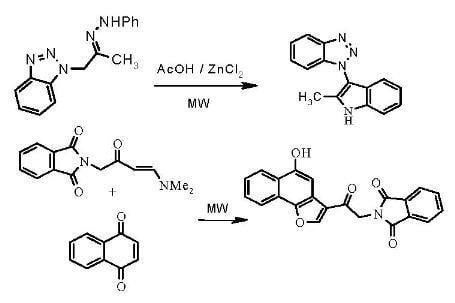Azolyacetones as Precursors to Indoles and Naphthofurans Facilitated by Microwave Irradiation with Simultaneous Cooling
Abstract
:Introduction
Results and Discussion





Conclusions
Experimental
General
2-(2-Oxo-2-phenylethyl)isoindole-1,3-dione (3b)
General method for preparation of compounds 4 and 7a
General method for preparation of compounds 8 and 9
2-Methyl-1H-indol-3-ylamine (11)
2-(4-Dimethylamino-2-oxobut-3-enyl)isoindole-1,3-dione (13)
2-[2-(5-Hydroxynaphtho[1,2-b]furan-3-yl)-2-oxoethyl]isoindole-1,3-dione (17)
Supplementary Files
Supplementary File 1Acknowledgments
References
- Al-Saleh, B.; Abdelkhalik, M.M.; El-Apasery, M.A.; Elnagdi, M.H. N-azolylmethyl ketones as building blocks in heterocyclic synthesis: Synthesis of new polyfunctionally substituted azolylarylazophenols, azolylpyridones and azolylthiophenes. J. Heterocyclic Chem. 2003, 40, 171–175. [Google Scholar] [CrossRef]
- Al-Saleh, B.; Behbehani, H.; El-Apasery, M.A.; Einagdi, M.H. Enaminones as building blocks in heterocyclic synthesis. Synthesis of polyfunctionally substituted 3-azolylpyridines and azolylazoloazines by thermal and microwave heating. J. Chem. Res. 2004, 8, 575–577. [Google Scholar]
- Al-Mousawi, S.; Abdel-Khalik, M.M.; El-Sherbiny, S.; John, E.; Elnagdi, M.H. Studies with enaminones: reactivity of 1,5-disubstituted-1,4-pentadien-3-ones toward electrophilic reagents. A novel route to azolylazines, benzofuranals, pyranones. J. Heterocycl. Chem. 2001, 38, 949–953. [Google Scholar]
- Al-Naggar, A.; Abdel-Khalik, M.M.; Elnagdi, M.H. Benzotriazol-1-yl-acetone as a building block in heterocyclic chemistry: A route to benzotriazolylpyridazines, benzotriazolyl-phthalazines and benzotriazolylpyrazolo [5,1-c]-1,2,4-triazines. J. Chem. Res. (s) 1999, 11, 648-649, (M), 2801-2810. [Google Scholar]
- Al-Saleh, B.; El-Apasery, M.A. Studies with condensed aminothiophenes: Further investigation on the reactivity of condensed aminothiophenes toward electron poor olefins and acetylenes under microwave heating. J. Heterocycl. Chem. 2006, 43, 559–564. [Google Scholar] [CrossRef]
- Al-Mousawi, S.; John, E.; Al-Kandery, N. Studies with enaminones: Synthesis and chemical reactivity of 2-(4-dimethylamino-2-oxobut-3-enyl)-isoindole-1,3-dione and of 4-(4-dimethylam-ino-2-oxobut-3-enyloxy)-2H-phthalazin-1-one. J. Heterocycl. Chem. 2004, 41, 381–385. [Google Scholar] [CrossRef]
- Al-Omran, F.; El-Khair, A.A. Heterocyclic synthesis via enaminones: Novel synthesis of (1H)-pyridin-2-one, pyrazolo[1,5-a]pyrimidine and isoxazole derivatives incorporating a N-methylphthalimide and their biological evaluation. J. Heterocycl. Chem. 2005, 42, 307–312. [Google Scholar] [CrossRef]
- Al-Omran, F.; El-Khair, A.A. 2-(3-Arylhydrazono-3-formyl-2-oxopropyl)-1H-isoindole-1,3(2H)-dione in heterocyclic synthesis. Novel derivatives of pyridazin-6(1H)-one, pyridazin-6(1H)-imine, and pyrazolo[5,1-c][1,2,4]triazine incorporating an N-(2-oxoethyl)phthalimide moiety. J. Chem. Res. 2006, 1, 6–9. [Google Scholar] [CrossRef]
- Al-Mousawi, S.M.; El-Apasery, M.A.; Al-Kanderi, N.H. Microwave-assisted organic synthesis: The Gabriel approach as a route to new pyrazolylhydrazonoazoles. ARKIVOC 2008, 16, 268–278. [Google Scholar]
- De Paulis, T.; Hemstapat, K.; Chen, Y.; Zhang, Y.; Saleh, S.; Alagille, D.; Baldwin, R.M.; Tamagnan, G.D.; Conn, P.J. Substituent effects of N-(1,3-diphenyl-1H-pyrazol-5-yl)benzamides on positive allosteric modulation of the metabotropic glutamate-5 receptor in rat cortical astrocytes. J. Med. Chem. 2006, 49, 3332–3344. [Google Scholar] [CrossRef]
- Sun, J.; Yan, C. Catalytic synthesis of N-alkylphthalimides under microwave irradiation. Huaxue Yanjiu 2002, 13, 39–40, [Chem. Abstr. 138: 187594]. [Google Scholar]
- Goossen, L.J.; Ghosh, K. Palladium-catalyzed synthesis of aryl ketones from boronic acids and carboxylic acids activated in situ by pivalic anhydride. Eur. J. Org. Chem. 2002, 19, 3254–3267. [Google Scholar] [CrossRef]
- Katritzky, A.R.; Wrobel, L.; Savage, G.P.; Deyrup-Drewniak, M. The formation of ketones by a reaction equivalent to R- + R'COCH2+ R'COCH2R. Aust. J. Chem. 1990, 43, 133–139. [Google Scholar] [CrossRef]
- Katritzky, A.R.; Wu, J.; Wrobel, L.; Rachwal, S.; Steel, P.J. Novel conversions of benzotriazol-1-ylmethyl derivatives. Acta Chem. Scand. 1993, 47, 167–175. [Google Scholar] [CrossRef]
- Anderson, D.J.; Gilchrist, T.L.; Gymer, G.E.; Rees, C.W. Reactive intermediates. XXII. Formation of 2H-azirines by oxidation of N-aminophthalimide in the presence of alkynes. J. Chem. Soc. Perk. Trans.1 1973, 6, 550–555. [Google Scholar]
- Bahekar, R.H.; Jain, M.R.; Goel, A.; Patel, D.N.; Prajapati, V.M.; Gupta, A.A.; Jadav, P.A.; Patel, P.R. Design, synthesis, and biological evaluation of substituted-N-(thieno[2,3-b]pyridin-3-yl)-guanidines, N-(1H-pyrrolo[2,3-b]pyridin-3-yl)-guanidines, and N-(1H-indol-3-yl)-guanidines. Bioorg. Med. Chem. 2007, 15, 3248–3265. [Google Scholar] [CrossRef]
- Al-Mousawi, S.M.; El-Apasery, M.A.; Elnagdi, M.H. Studies with condensed aminothiophenes: Microwave assisted cycloaddition reactions of thieno[3,4-d]pyridazinone and thieno[3,4-c]quinolinone. Heterocycles 2008, 75, 1151–1161. [Google Scholar]
- Hassanien, A.A.; Ghozlan, S.A.S.; Elnagdi, M.H. Studies with functionally substituted methylbenzotriazoles: Novel synthesis of functionally substituted pyrazolo[5,1-c]-1,2,4-triazines benzotriazol-1-yl, 1-pyrazol-4-yl benzotriazoles and 1-isoxazol-4-yl benzotriazoles. J. Chin. Chem. Soc. 2004, 51, 575–579. [Google Scholar]
- Sample Availability: Samples of the compounds 1-17 are available from the authors.
© 2009 by the authors; licensee Molecular Diversity Preservation International, Basel, Switzerland. This article is an open access article distributed under the terms and conditions of the Creative Commons Attribution license ( http://creativecommons.org/licenses/by/3.0/).
Share and Cite
Al-Mousawi, S.M.; El-Apasery, M.A. Azolyacetones as Precursors to Indoles and Naphthofurans Facilitated by Microwave Irradiation with Simultaneous Cooling. Molecules 2009, 14, 2976-2984. https://doi.org/10.3390/molecules14082976
Al-Mousawi SM, El-Apasery MA. Azolyacetones as Precursors to Indoles and Naphthofurans Facilitated by Microwave Irradiation with Simultaneous Cooling. Molecules. 2009; 14(8):2976-2984. https://doi.org/10.3390/molecules14082976
Chicago/Turabian StyleAl-Mousawi, Saleh Mohammed, and Morsy Ahmed El-Apasery. 2009. "Azolyacetones as Precursors to Indoles and Naphthofurans Facilitated by Microwave Irradiation with Simultaneous Cooling" Molecules 14, no. 8: 2976-2984. https://doi.org/10.3390/molecules14082976




